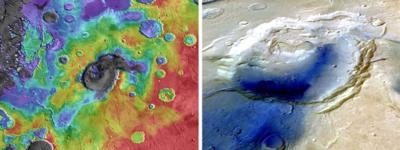Mon, Oct 28, 2013
NASA, Planetary Science Institute Reveal The Discovery
Scientists from NASA and the Planetary Science Institute in Tucson, Ariz., have identified what could be a supervolcano on Mars—the first discovery of its kind. The volcano in question, a vast circular basin on the face of the Red Planet, previously had been classified as an impact crater. Researchers now suggest the basin is actually what remains of an ancient supervolcano eruption. Their assessment is based on images and topographic data from NASA's Mars Odyssey, Mars Global Surveyor and Mars Reconnaissance Orbiter spacecraft, as well as the European Space Agency's Mars Express orbiter.

In the Oct. 3 issue of the journal Nature, Joseph Michalski, a researcher affiliated with the Planetary Science Institute and the Natural History Museum in London, and Jacob Bleacher of NASA's Goddard Space Flight Center in Greenbelt, Md., laid out their case that the basin, recently named Eden Patera, is a volcanic caldera. Because a caldera is a depression, it can look like a crater formed by an impact, rather than a volcano. "On Mars, young volcanoes have a very distinctive appearance that allows us to identify them," said Michalski. "The long-standing question has been what ancient volcanoes on Mars look like. Perhaps they look like this one."
The researchers also suggest a large body of magma loaded with dissolved gas (similar to the carbonation in soda) rose through thin crust to the surface quickly. Like a bottle of soda that has been shaken, this supervolcano would have blown its contents far and wide if the top came off suddenly. "This highly explosive type of eruption is a game-changer, spewing many times more ash and other material than typical, younger Martian volcanoes," said Bleacher. "During these types of eruptions on Earth, the debris may spread so far through the atmosphere and remain so long that it alters the global temperature for years."
After the material is expelled from the eruption, the depression that is left can collapse even further, causing the ground around it to sink. Eruptions like these happened in ages past at what is now Yellowstone National Park in the western United States, Lake Toba in Indonesia and Lake Taupo in New Zealand.
Volcanoes previously had not been identified in the Arabia Terra region of Mars, where Eden Patera is located. The battered, heavily eroded terrain is known for its impact craters. But as Michalski examined this particular basin more closely, he noticed it lacked the typical raised rim of an impact crater. He also could not find a nearby blanket of ejecta, the melted rock that splashes outside the crater when an object hits.
The absence of such key features caused Michalski to suspect volcanic activity. He contacted Bleacher, a volcano specialist, who identified features at Eden Patera that usually indicate volcanism, such as a series of rock ledges that looked like the "bathtub rings" left after a lava lake slowly drains. In addition, the outside of the basin is ringed by the kinds of faults and valleys that occur when the ground collapses because of activity below the surface. The existence of these and other volcanic features in one place convinced the scientists Eden Patera should be reclassified.
The team found a few more candidates for reclassification nearby, suggesting conditions in Arabia Terra may have been favorable for supervolcanoes. It is also possible massive eruptions here could have been responsible for volcanic deposits elsewhere on Mars that have never been linked to a known volcano. "If just a handful of volcanoes like these were once active, they could have had a major impact on the evolution of Mars," Bleacher said.
(Image provided by NASA)
More News
Runway Lead-in Light System Runway Lead-in Light System Consists of one or more series of flashing lights installed at or near ground level that provides positive visual guidance a>[...]
Aero Linx: Aviation Without Borders Aviation Without Borders uses its aviation expertise, contacts and partnerships to enable support for children and their families – at hom>[...]
Dave Juwel's Aviation Marketing Stories ITBOA BNITBOB ... what does that mean? It's not gibberish, it's a lengthy acronym for "In The Business Of Aviation ... But Not In The Busine>[...]
From 2010 (YouTube Version): Yeah.... This IS A Really Cool Job When ANN's Nathan Cremisino took over the lead of our Aero-TV teams, he knew he was in for some extra work and a lot>[...]
Also: Junkers A50 Heritage, Montaer Grows, Dynon-Advance Flight Systems, Vans' Latest Officially, the Carbon Cub UL and Rotax 916 iS is now in its 'market survey development phase'>[...]
 ANN's Daily Aero-Term (04.24.24): Runway Lead-in Light System
ANN's Daily Aero-Term (04.24.24): Runway Lead-in Light System ANN's Daily Aero-Linx (04.24.24)
ANN's Daily Aero-Linx (04.24.24) Aero-FAQ: Dave Juwel's Aviation Marketing Stories -- ITBOA BNITBOB
Aero-FAQ: Dave Juwel's Aviation Marketing Stories -- ITBOA BNITBOB Classic Aero-TV: Best Seat in The House -- 'Inside' The AeroShell Aerobatic Team
Classic Aero-TV: Best Seat in The House -- 'Inside' The AeroShell Aerobatic Team Airborne Affordable Flyers 04.18.24: CarbonCub UL, Fisher, Affordable Flyer Expo
Airborne Affordable Flyers 04.18.24: CarbonCub UL, Fisher, Affordable Flyer Expo



